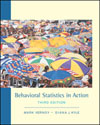Mark W. Vernoy,
Palomar College
Diana J. Kyle,
Fullerton College
| Apparent limits | are the limits of a class interval in the same units as the original data.
|
 |
 |
 |
| Class intervals | are equal-sized groups of raw data used to summarize data in a grouped frequency distribution.
|
 |
 |
 |
| Cumulative frequency | ( cum ƒ )is the total number of scores that fall below the upper real limit of an interval.
|
 |
 |
 |
| Cumulative percent | ( cum %)is also known as percentile. It is the percentage of scores that fall below the exact upper limit of the interval.
cum % = cum rel ƒ · 100
|
 |
 |
 |
| Cumulative relative frequency | ( cum rel ƒ )is the total proportion of scores that lie below the real upper limit of the interval.  <a onClick="window.open('/olcweb/cgi/pluginpop.cgi?it=gif:: ::/sites/dl/free/0767422759/35691/c2gi5.gif','popWin', 'width=130,height=56,resizable,scrollbars');" href="#"><img valign="absmiddle" height="16" width="16" border="0" src="/olcweb/styles/shared/linkicons/image.gif"> (2.0K)</a> <a onClick="window.open('/olcweb/cgi/pluginpop.cgi?it=gif:: ::/sites/dl/free/0767422759/35691/c2gi5.gif','popWin', 'width=130,height=56,resizable,scrollbars');" href="#"><img valign="absmiddle" height="16" width="16" border="0" src="/olcweb/styles/shared/linkicons/image.gif"> (2.0K)</a>
|
 |
 |
 |
| Frequency | ( ƒ ) is the number of times a score occurs. The sum of the frequencies in a distribution is equal to the total number of scores in the distribution.  <a onClick="window.open('/olcweb/cgi/pluginpop.cgi?it=gif:: ::/sites/dl/free/0767422759/35691/sfn.gif','popWin', 'width=64,height=30,resizable,scrollbars');" href="#"><img valign="absmiddle" height="16" width="16" border="0" src="/olcweb/styles/shared/linkicons/image.gif"> (0.0K)</a> <a onClick="window.open('/olcweb/cgi/pluginpop.cgi?it=gif:: ::/sites/dl/free/0767422759/35691/sfn.gif','popWin', 'width=64,height=30,resizable,scrollbars');" href="#"><img valign="absmiddle" height="16" width="16" border="0" src="/olcweb/styles/shared/linkicons/image.gif"> (0.0K)</a>
|
 |
 |
 |
| grouped frequency distribution | in this distribution, the raw data are combined into equal-sized groups called class intervals. The rule of thumb is to create between 10 and 20 class intervals and adjust the size of the intervals accordingly.  <a onClick="window.open('/olcweb/cgi/pluginpop.cgi?it=gif:: ::/sites/dl/free/0767422759/35691/c2gi2.gif','popWin', 'width=446,height=54,resizable,scrollbars');" href="#"><img valign="absmiddle" height="16" width="16" border="0" src="/olcweb/styles/shared/linkicons/image.gif"> (6.0K)</a> <a onClick="window.open('/olcweb/cgi/pluginpop.cgi?it=gif:: ::/sites/dl/free/0767422759/35691/c2gi2.gif','popWin', 'width=446,height=54,resizable,scrollbars');" href="#"><img valign="absmiddle" height="16" width="16" border="0" src="/olcweb/styles/shared/linkicons/image.gif"> (6.0K)</a>
|
 |
 |
 |
| Midpoint | is the average (center) of a class interval.  <a onClick="window.open('/olcweb/cgi/pluginpop.cgi?it=gif:: ::/sites/dl/free/0767422759/35691/c2gi3.gif','popWin', 'width=302,height=58,resizable,scrollbars');" href="#"><img valign="absmiddle" height="16" width="16" border="0" src="/olcweb/styles/shared/linkicons/image.gif"> (5.0K)</a> <a onClick="window.open('/olcweb/cgi/pluginpop.cgi?it=gif:: ::/sites/dl/free/0767422759/35691/c2gi3.gif','popWin', 'width=302,height=58,resizable,scrollbars');" href="#"><img valign="absmiddle" height="16" width="16" border="0" src="/olcweb/styles/shared/linkicons/image.gif"> (5.0K)</a>
|
 |
 |
 |
| Range | is the full extent of scores from the highest to the lowest in the distribution.
|
 |
 |
 |
| Ranked distribution | is a distribution of numbers in which scores are arranged in order (ranked), with the highest number at the top and the lowest number at the bottom of a list.
|
 |
 |
 |
| Raw data | are the scores or numbers that have been collected but not organized or summarized.
|
 |
 |
 |
| Real limits | are the true extensions of the lower apparent limit minus 0.5 unit and the upper apparent limit plus 0.5 unit.
|
 |
 |
 |
| Relative frequency | ( rel ƒ )is the proportion of scores from the distribution that fall within the real limits of an interval.  <a onClick="window.open('/olcweb/cgi/pluginpop.cgi?it=gif:: ::/sites/dl/free/0767422759/35691/c2gi4.gif','popWin', 'width=89,height=58,resizable,scrollbars');" href="#"><img valign="absmiddle" height="16" width="16" border="0" src="/olcweb/styles/shared/linkicons/image.gif"> (1.0K)</a> <a onClick="window.open('/olcweb/cgi/pluginpop.cgi?it=gif:: ::/sites/dl/free/0767422759/35691/c2gi4.gif','popWin', 'width=89,height=58,resizable,scrollbars');" href="#"><img valign="absmiddle" height="16" width="16" border="0" src="/olcweb/styles/shared/linkicons/image.gif"> (1.0K)</a>
|
 |
 |
 |
| Simple frequency distributions | are created by listing all possible score values in a distribution and then indicating the frequency.
|



 2002 McGraw-Hill Higher Education
2002 McGraw-Hill Higher Education